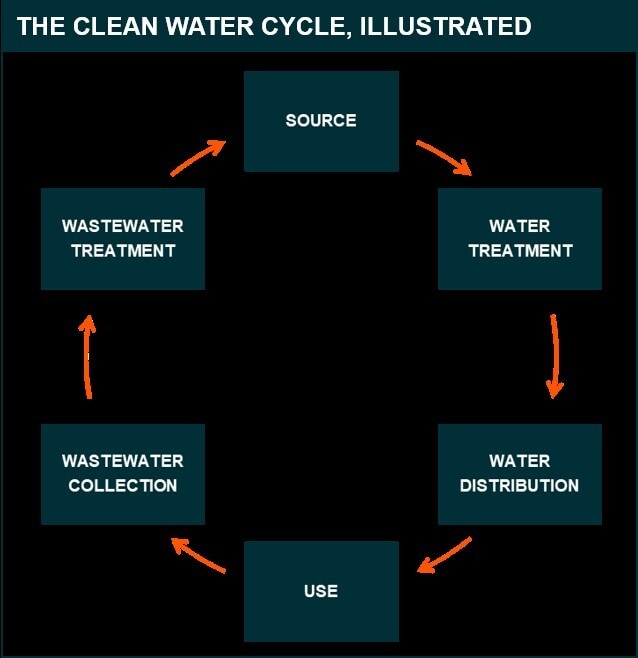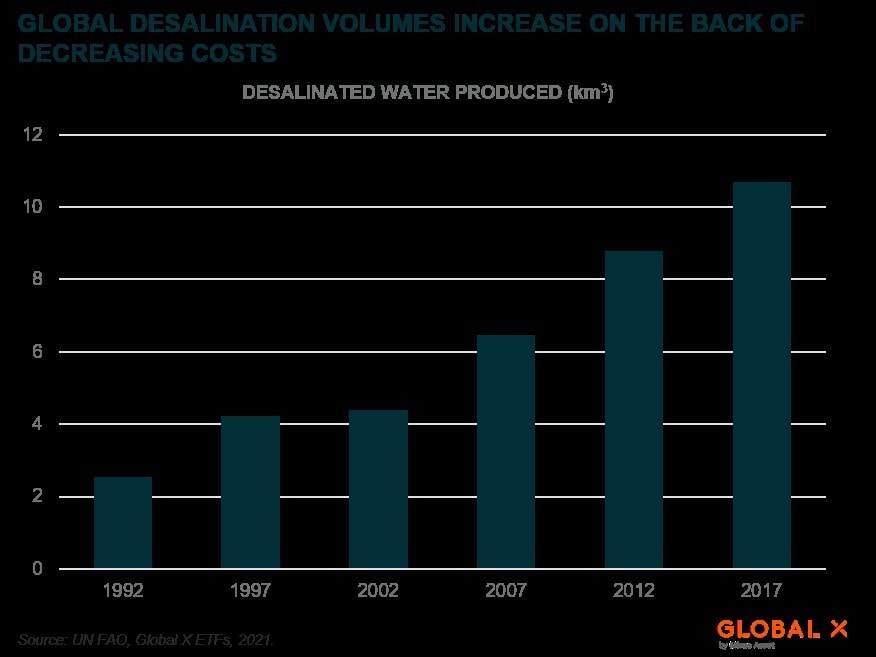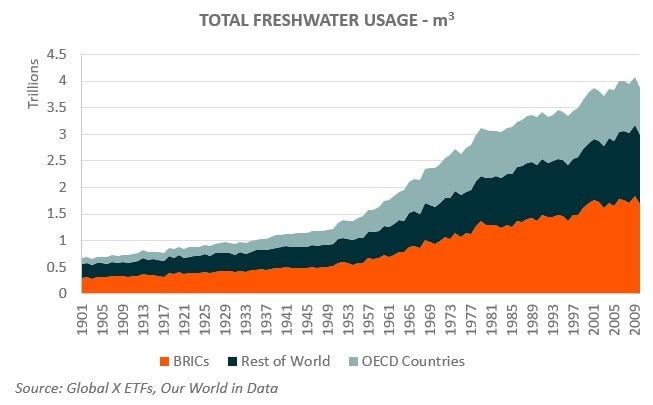In this article, Andrew Little, a research analyst at Global X, explores the most recent addition to the firm’s ETF offering and why clean water is an intriguing investment theme.
On April 12th, 2021, we listed the Global X Clean Water ETF [AQWA] on Nasdaq.
The fund seeks to invest in companies advancing the provision of clean water through industrial water treatment, storage and distribution infrastructure, as well as purification and efficiency strategies among other activities. Further, it incorporates environmental, social and governance (ESG) screens and follows ESG proxy voting guidelines to affect positive change alongside financial returns.
Access to clean water is becoming a dire global challenge — one that may require rethinking all aspects of the water value chain with a greater focus on sustainability and making significant investments in water infrastructure and related products and services.
Water fuels life on earth and is a fundamental input for economic productivity. While it is seemingly abundant, competing uses and structural challenges presented by population growth, pollution, and climate change are stretching water resources precariously thin.
Clean water — the water we drink, prepare our food with, and use for sanitation — faces the most immediate pressure with the direst societal and economic impacts. Over 2.3 billon people live in water-stressed countries and in 2019, unsafe drinking water resulted in more deaths than diabetes, malaria, or HIV/AIDs. (1,2,3)
Sub-optimal water management practices, alongside neglected water infrastructure development and maintenance, is much to blame for our current predicament. Fortunately, a shift to a more sustainable model is possible, led by government policy, technological innovation, and growing consumer and public health advocacy. Keys to this transition include:
• Sustainable and next-generation water sourcing
• Innovation in water treatment and distribution
• Wastewater management and water reuse
In the following piece, we delve into the current challenges in the water value chain, explore how modernised water management and infrastructure will be critical to turning the tide on this crisis, and discuss how Global X Clean Water ETF provides exposure to this critical theme.
Sustainability starts at the source
Boundless oceans and towering glaciers deceive many into believing that we have a limitless supply of water to draw from. But in fact, only 0.3% of all water on earth is useable.(4)And to get that useable water into our homes, farms, and businesses, it must follow a multi-faceted cycle, which touches a variety of companies and services.

Nearly all water used by humans comes from freshwater sources that are replenished by precipitation (rain, snow, hail) and are typically classified as either surface water or groundwater. Surface water comes from lakes, reservoirs, ponds, rivers, streams, and other low-saline bodies of water and is extracted (abstracted) using motorised pumps, infiltration galleries (drains), and/or diversion structures that direct flowing water to a collection site. Groundwater, on the other hand, exists under the Earth’s surface in aquifers, which are permeable rock formations that can be drilled into and pumped for water.
For centuries, humans drew freshwater from surface and groundwater sources with minimal concerns for sustainability. Populations were many times smaller and technological limitations prevented unsustainable levels of extraction. Precipitation could replenish these sources much faster than they were used.
In modern times, freshwater resources are becoming stretched thin. In 2018, 16 countries (representing 552 million people) withdrew freshwater at a rate that exceeded their internal renewable water resources (IRWR), which is defined as the long-term average annual flow of rivers and recharge of aquifers generated from endogenous precipitation.
Further, there are 36 countries (2.3 billion people) with withdrawal rates that exceeded 50% of their IRWR and 58 countries (4.9 billion people) with withdrawal rates that exceeded 25% of their IRWR.(5) Any rate above 25% is considered a water-stressed region and could put millions at risk. It might also result in over-extraction which can deplete water resources permanently.(6) For example, the over-extraction of aquifers can result in detrimental saltwater infiltration. In short, in many regions around the world water usage is becoming unsustainable as water demand rises.
Making matters worse, freshwater supply could be threatened by climate change.
Rising global temperatures accelerate extreme weather events like heatwaves that cause draught conditions, and powerful storms that can damage water infrastructure or overwhelm sewage operations, contaminating the water supply. A NASA study predicts that a mega-drought, one lasting more than three decades, is increasingly likely to hit the US Southwest and Central Plains regions. On our current greenhouse gas emissions trajectory, the odds of a mega-drought are as high as 80% by the latter half of this century.(7)
So, what is the solution? First and foremost, finding new sources of freshwater is paramount. Desalination of abundant seawater presents one potential option, particularly for coastal regions. For many years, desalination was too expensive to be viable and there was limited supportive infrastructure. But in the past three decades, the cost of desalination fell 50%, while the volume of freshwater produced by the process rose by 320%.(8,9)

Seawater makes up 97.2% of all water on earth and continued cost improvements to reverse osmosis desalination technology could turn the tides in the global fight against water scarcity.(10) Other potential freshwater sources include rainwater and fog harvesting, though neither have yet to see widespread adoption.
Next, enhancements must be made to existing water extraction approaches and operations. Disruptive tech-based solutions like connected sensors and artificial intelligence can monitor aquifers and surface sources in real time. Supervisory, control, and data acquisition systems, for example, measure water levels, monitor wells for infiltrations, and automate pumping.(11) Implementing these types of technologies can help mitigate irreparable damage to global water resources.
Nextgen infrastructure and technology can improve water quality
Over a decade ago, the United Nations General Assembly recognised access to clean water and sanitation as a human right. Despite this proclamation, water-related disease continues to be a leading cause of illness and in 2019 likely contributed to an alarming 2.7% of all global deaths.(12)
Inadequate access to safely managed drinking water is the primary culprit: 2.2 billion people lack access to safely managed drinking water, about 580 million of whom drink from unprotected surface sources like lakes, ponds, and wells.(13) The World Health Organization defines safely managed drinking water as “an improved drinking water source which is located on premises, available when needed, and free of faecal and priority chemical contamination.”(14)Water treatment and distribution are key enablers of this within the clean water cycle.
Water treatment is the process of bringing raw freshwater up to safe standards for its end-use, which in most cases is drinking water. Conventional treatment for drinking water is as follows:
Coagulation/Flocculation: Chemicals with positive charges like aluminium sulphate and ferric sulphate are added to the water, forcing small suspended and dissolved particles to bind, or coagulate, into larger particles called flocs.
Sedimentation: The water sits in a sedimentation tank until the flocs settle at bottom as sediment. Particle settling times vary, requiring further steps to remove lighter particles like viruses and certain minerals (ions).
Filtration: After sediment is removed, the water is filtered through porous media to remove particulate. This can be a multistep process that starts with large filtration through sand, gravel, and porous fibres and end with innovative filtration techniques like nano filtration and reverse osmosis.
Disinfection: Prior to distribution, the water is disinfected to kill any remaining micro-organisms. Most commonly, chlorine, chloramines, and carbon dioxide are used due to their cost-effectiveness.
Once treated, water needs to be distributed safely and efficiently to its end-users. In populated areas of advanced economies, treated water is often pumped into an elevated tank, which then provides pressurised water across an underground pipe network. Yet in many cases, this infrastructure has been neglected, resulting in wasteful and dangerous practices.
In the United States, an estimated $7.6bn of treated drinking water was lost in 2019 due to leaky pipes — a figure that could double to $16.7bn by 2039 without substantial investment.(15) And worse, 6-10 million people in the US still receive their drinking water through lead pipes and service lines, which is poisonous and can cause developmental issues in children and reduced cardiovascular and kidney functions in adults.
These shortcomings resulted in a C- grade for the US’s drinking water infrastructure from the American Society of Civil Engineers and is a leading reason for Biden including $111bn in proposed funding for water systems in his American Jobs Plan.(16)
Beyond the borders of the US, many other developed nations face similar treatment and distribution issues, but the situation is often even more dire in developing markets, where water distribution can be much less safe or efficient, or even non-existent.
Technological advancements in water treatment tend to focus on improved methods for removing contaminates — either doing so more efficiently or relying less on chemical additives. Such technologies include membrane filtration, ultraviolet irradiation, and nanoparticle purification.(17) The latest in water distribution technologies allow for real time monitoring of quality and usage rates, AI-based forecasting of future demand trends, and dynamic adjustments to water networks to meet these needs. Ultimately, upgrading water treatment and improving distribution via the latest technologies could result in much more efficient, safe, and resilient water systems.
Water use — closing the spigot
From 2002 to 2017, the global population increased 21% to 7.6 billion people and municipal and agricultural water withdrawals increased by 12%.(18) Water demand increasing at a slower rate than population growth is ostensibly a sign of greater water usage efficiency, but overall population growth continues to pressure systems worldwide.

BRICs= Brazil, Russia, India, and China
Globally, 71% of freshwater is used for agricultural purposes, whereas roughly 17% is used by industry, and 12% for households.19 Growing populations alongside a quickly rising middle class in emerging markets are resulting in rising demand for water-intensive agricultural products like crops, meat, and dairy. It is expected that by 2050, total water usage will increase 15% above today’s levels to serve approximately 9 billion people around the world.(20)
Fortunately, water usage can continue to become more efficient per capita to alleviate the pressures of population and economic growth. At a local level, implementing water preservation-focused policies, like banning lawn watering during mid-day when evaporation is at its peak; establishing building codes that require low-flow toilets, faucets, and showerheads; and dynamic and tiered pricing, can all help reduce consumption patterns.
In addition, the further adoption of cutting-edge technologies in agriculture like precision irrigation, indoor farming, and crop modification can further reduce water usage, while maintaining similar levels of food production.
Wastewater management and reuse
The world is a closed system — every drop of water used to shower in the morning, grow a stalk of corn, or cool a data centre ultimately finds its way back to the ecosystem. Much is evaporated in the atmosphere and through precipitation returns to the earth, but stormwater, domestic sewage, and industrial wastewater accumulate in vast quantities that require infrastructure and treatment processes to safely manage.
Municipal wastewater is typically collected through combined sewer systems which merge stormwater and domestic sewage through underground pipes. This water is then brought to a treatment plants which conduct two stages of treatment:
Primary Treatment: Solid materials are removed by screening and filtering large objects or grinding materials into smaller fragments. The water then sits in tanks where remaining solid materials either float to the top or fall to the bottom as sediment, which is then removed.
Secondary Treatment: Secondary treatment seeks to purify the water further by removing soluble organic matter. This stage of treatment utilises bacteria to breakdown organic matter, before being treated with chlorine to disinfect the water. The water is then dechlorinated to remove chemicals before being pumped to surface water sources.(21)
Agricultural and industrial wastewater treatment processes differ from this and are often more challenging as they must safely remove chemicals and other inorganic pollutants.
As suspected, this process of collecting and treating wastewater is costly — at least in a vacuum where public health and environmental damage is not being factored in — and therefore is often unavailable in poorer regions. Globally, it is expected that 80% wastewater returns to the ecosystem without receiving any treatment, endangering approximately 1.8 billion people who risk contracting cholera, dysentery, typhoid and polio by drawing water from these polluted systems.(22)
For many areas, the answer to these challenges is simply more funding to build adequate sewage and wastewater treatment facilities. For existing infrastructure, however, there are still several improvements that should be implemented, including increased capacity and resilience to handle powerful storms that often overwhelm systems; retrofitting facilities for greater electric efficiency (which can reduce operating costs and capture geothermal energy); replacing chlorine treatments with ultraviolet disinfection techniques; and integrating greater automation and software in daily operations.
AQWA — providing exposure to the global clean water value chain
The Global X Clean Water ETF is designed to provide investors efficient and targeted exposure to several aspects of the global clean water chain that we believe will both benefit from increased funding for water infrastructure and solutions, and play critical roles in addressing the global water crisis. This includes companies that derive at least 50% of their revenues, operating income, or assets from:
• industrial water treatment, recycling (including water reclamation), purification, and conservation;
• water storage, transportation, metering, and distribution infrastructure;
• production of household and commercial water purifier and heating products; and
• provision of consulting services identifying and implementing water efficiency strategies at the corporate and/ or municipal levels.
Beyond selecting companies based on their pure-play exposure to the clean water value chain, AQWA’s underlying index also incorporates environmental, social and governance screens into its selection process to avoid potential bad actors in the space and AQWA follows ESG proxy voting guidelines to affect positive change alongside financial returns.
This article was originally written and published by Global X. The original article, which includes footnotes where readers can find the original source material, can be found here.
SEI Investments Distribution Co. (1 Freedom Valley Drive, Oaks, PA, 19456) is the distributor for the Global X Funds.
Check the background of SIDCO and Global X’s Registered Representatives on FINRA’s BrokerCheck.
Investing involves risk, including the possible loss of principal. The investable universe of companies in which AQWA may invest may be limited. International investments may involve risk of capital loss from unfavorable fluctuation in currency values, from differences in generally accepted accounting principles or from social, economic or political instability in other nations. Emerging markets involve heightened risks related to the same factors as well as increased volatility and lower trading volume. Clean Water Companies typically face intense competition, short product lifecycles and potentially rapid product obsolescence. Clean Water Companies are subject to significant regulation regarding the usage, treatment, and distribution of water. Clean Water Companies may also be adversely affected by the impact of global climate change on the available supply of clean water reserves. AQWA is non-diversified.
Shares of ETFs are bought and sold at market price (not NAV) and are not individually redeemed from the Fund. Brokerage commissions will reduce returns.
Carefully consider the Fund’s investment objectives, risks, and charges and expenses before investing. This and other information can be found in the Fund’s summary or full prospectuses, which may be obtained at globalxetfs.com. Please read the prospectus carefully before investing.
Global X Management Company LLC serves as an advisor to Global X Funds. The Funds are distributed by SEI Investments Distribution Co. (SIDCO), which is not affiliated with Global X Management Company LLC or Mirae Asset Global Investments. Global X Funds are not sponsored, endorsed, issued, sold or promoted by Solactive AG, nor does Solactive AG make any representations regarding the advisability of investing in the Global X Funds. Neither SIDCO, Global X nor Mirae Asset Global Investments are affiliated with Solactive AG.
Disclaimer Past performance is not a reliable indicator of future results.
CMC Markets is an execution-only service provider. The material (whether or not it states any opinions) is for general information purposes only, and does not take into account your personal circumstances or objectives. Nothing in this material is (or should be considered to be) financial, investment or other advice on which reliance should be placed. No opinion given in the material constitutes a recommendation by CMC Markets or the author that any particular investment, security, transaction or investment strategy is suitable for any specific person.
The material has not been prepared in accordance with legal requirements designed to promote the independence of investment research. Although we are not specifically prevented from dealing before providing this material, we do not seek to take advantage of the material prior to its dissemination.
CMC Markets does not endorse or offer opinion on the trading strategies used by the author. Their trading strategies do not guarantee any return and CMC Markets shall not be held responsible for any loss that you may incur, either directly or indirectly, arising from any investment based on any information contained herein.
*Tax treatment depends on individual circumstances and can change or may differ in a jurisdiction other than the UK.
Continue reading for FREE
- Includes free newsletter updates, unsubscribe anytime. Privacy policy






